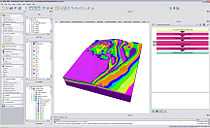IRAP RMS Suite
|
RMS 2009 running on Windows XP. | |
| Original author(s) | Geomatic |
|---|---|
| Developer(s) | Roxar AS |
| Initial release | 1987 |
| Stable release | RMS 2012 / March 27, 2012 |
| Development status | Active |
| Operating system |
Microsoft Windows Linux |
| Platform | Cross-platform |
| Type | Computer-aided engineering |
| License | Proprietary |
| Website | |
The Roxar RMS Suite is a software toolkit for geomodelling[1] and designing reservoirs. It is primarily designed for use in the oilfield industry, helping engineers gather data from a wide variety of sources to efficiently build reliable reservoirs. In the program, the workflow consists of Internal Programming Language scripts,[2] which execute emulations of certain models, varying one parameter, whilst keeping the rest consistent.[3]
History
- 1987 - Geomatic begins distribution of the first version of the IRAP software.
- 1994 - IRAP becomes IRAP RMS, the industry’s first 3D modelling package.
- 1995 - Smedvig Technologies, later known as Roxar AS, acquires Geomatic AS and ODIN Reservoir Software. Smedvig’s analysis and processing software, ResView, ODIN's tool for stochastic reservoir modelling,[4] STORM, and Geomatic's IRAP reservoir modelling software merge into IRAP RMS.
- 2009 - Roxar is acquired by Emerson, St.Louis USA and becomes part of a USD 28 billion company.
Versions
Version 6
In version 6, STORM’s stochastic modelling was merged with structure and fault modelling capabilities. Also introduced was the 'Workflow Manager' tool, which allows users to build and update reservoir models quickly.
Version 7
- Native Windows compatibility.
New modules
| Module | Description |
|---|---|
| RMSwellplan | A user friendly oil well planning tool. |
| RMSflowsim | A flow simulator that integrates dynamic reservoir data with the static model. |
| RMSwellstrat | A well correlation tool. |
| RMSfaultseal | A module designed to analyse and provide data on the optimal ways to seal faults. |
| FracPerm | A fracture modeller/simulator. |
RMS 2009
RMS2009 has a new user interface. Other key features of the release include improved structural modelling, data import and a new local model update module. It also has real-time well monitoring.
RMS 2010
RMS 2010 was released in February 2010. RMS 2010 comes with major improvements across the entire workflow, with a wide-ranging makeover of the well correlation tools, new model building and property modelling tools and improved 3D gridding and better communication with external simulators.
RMS 2011
RMS 2011 was released in May 2011. RMS 2011 comes with more new features than any previous RMS version and provides modellers with enhancements to the seismic architecture to allow direct reference between the reservoir models and the 3D and 4D seismic data that the interpretation and modelling is based on. Key highlights of RMS 2011 include new tools to model complex geologies and incorporate 4D seismic into the workflow; geological well correlation improvements; new fracture modelling capabilities; and usability and integration features that make RMS 2011 even more accessible and easy to use, while at the same time realistically modelling some of the world’s most complex geologies.
RMS 2012
RMS 2012 was released in March 2012 and came with new seismic inversion, seismic attributes, and field planning capabilities to help operators generate more accurate and realistic reservoir models and increase recovery rates.
See also
References
- ↑ Lecourtier, Jacqueline (2001). Interactive drilling for fast track oilfield development. Technip. p. 15. ISBN 2-7108-0804-8.
- ↑ SPE Formation Evaluation: An Official Publication of the Society of Petroleum Engineers (12 ed.). Society of Petroleum Engineers. 1996. p. 141.
- ↑ Robinson, A.; J. Hegre; S. Price (2009). The Future of Geological Modelling in Hydrocarbon Development. Geological Society. p. 196. ISBN 1-86239-266-8.
- ↑ Baafi, Ernest Y.; Neil A. Schofield (1997). Geostatistics Wollongong '96. Springer. p. 366. ISBN 0-7923-4495-2.
